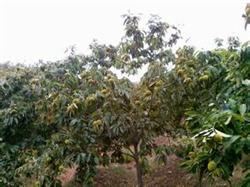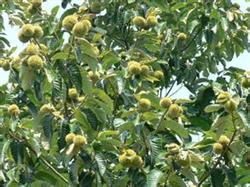There are four ways to save water in mountain chestnut

Covering trees with grass is an economical, convenient and labor-saving technical measure, which can make full use of weeds growing on hillsides and straw after harvest of crops. It can not only store water and preserve moisture, but also increase soil organic matter content, so as to enhance soil ventilation and water permeability. The specific method is: covering weeds or harvested corn stalks from inside to outside along the tree tray, with a thickness of 10~15 cm. After covering, sprinkle a small amount of soil on it to prevent wind blowing or fire. Supplement mulching once a year and deep ploughing once every 3~4 years. After mulching decays, soil nutrients can be increased. Mulching plastic film on tree tray can not only increase ground temperature for root growth and promote germination, but also significantly reduce soil moisture evaporation. The area covered varies with the age of the tree, and the minimum area cannot be less than the area of the tree tray. After the film is covered, the surrounding area is compacted with soil to prevent it from being blown away by the wind. Digging holes under the tree crown is suitable for most chestnut forests prepared by engineering and chestnut forests planted on steep slopes. The concrete method is: take the trunk as the center, carry on the triangle radial diffusion to all around, arrange the tree tray into several small pits. The size and shape of the pit vary according to the terrain. The depth and width of the pit are about 30 cm respectively. The number of pits depends on the size of the crown. The coverage of the pit can extend to 2~3 meters outside the crown. This can effectively control soil erosion and play a role in water conservation, soil conservation and fertilizer conservation. The operation of the cave water storage fertilizer is simple and practical. This is done by: before the tree body germinates, digging a pit along the periphery of the tree crown, wherein the diameter of the pit is 30 - 40cm and the depth of the pit is 40 - 50cm; vertically putting straw bundles bundled with wheat straw or weeds and the like into the pit; adding a small amount of long-acting compound fertilizer into uniformly mixed fine soil to backfill the periphery of the straw bundles in the pit; stabilizing and leveling the ground; covering soil at the top of the straw bundles by 2 - 3cm; watering by 4 - 5kg; covering plastic film on the pit; pressing soil at the periphery of the pit to make the pit bottom shape with the middle low and the periphery high; and opening a small hole in the center, The watering and fertilization after film mulching are carried out on the holes, usually pressed with soil blocks to prevent evaporation.
- Prev

High-yield cultivation techniques of Organic Chestnut
To do a good job in winter pruning of chestnut trees in the full fruit period is an effective measure to prolong the full fruit period and prevent the occurrence of fruit in large and small years. 1. It is appropriate to prune Chinese chestnut in winter, from half a month after falling leaves to half a month before sprouting in spring next year, that is, from mid-December to early February of the following year, but encounter ice.
- Next

Water-saving technology of Chinese chestnut in mountainous area
Chestnut stem blight, also known as chestnut carcass blight, chestnut rot, chestnut blight, is one of the main diseases of chestnut. It occurred in all the main chestnut producing areas in China, and some of them suffered seriously, and the chestnut planted in Nanxiong also suffered seriously. The bark of the killed chestnut tree rotted and the tree became weak, which resulted in dead branches and dead trees. First, danger.
Related
- Moge, come on! The staff of the peasant association in the producing area of cantaloupe were frightened when the crowd gathered.
- Causes and Solutions of low Fruit setting rate of Apple
- Symptoms and control measures of passion fruit virus disease
- Fruit growing lesson: how do apple orchards keep high yields?
- Can you build orchards in the mountains? What are the pros and cons?
- How to manage the coloring period of Crisson grape?
- This paper introduces the processing technology of two kinds of fig products.
- How much is a month for retired teachers in rural areas by 2020?
- How can strawberry planting increase sugar content? We should pay attention to management in many aspects.
- What are the cultivation techniques on how to improve the yield of golden fruit?

